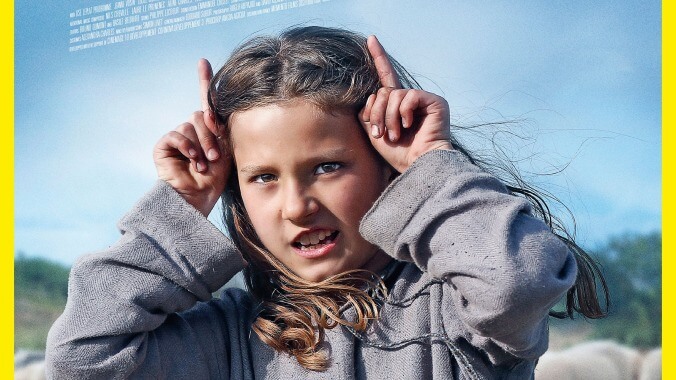The dabbing, rapping medieval metal musical Jeannette is even stranger than it sounds

It’s a stereotype of comedians that they want to be taken seriously; think Woody Allen’s Bergman worship or The Day The Clown Cried, to cite a couple of the more notorious cases. But how often does the opposite happen, that a more or less humorless moralist sets out to reinvent themselves as a jokester? Bruno Dumont is the rare example. Once one of the biggest names in miserablist European art cinema, the French filmmaker behind Humanité and Twentynine Palms has embraced self-parody and increasing levels of wackiness since the 2014 small-town-mystery miniseries Li’l Quinquin, all the while retaining the landscape-painting austerity of his visual style as a killer straight face, like an arthouse-director Leslie Nielsen. Quinquin was followed by Slack Bay, a baffling early-20th-century farce about inbred haute bourgeois and cannibals that featured Pythonesque gags and a cast of veteran French actors (including Juliette Binoche and Fabrice Luchini) in the most bizarre performances of their careers. And now, Jeannette: The Childhood Of Joan Of Arc, which adapts two (very serious) plays by the idiosyncratic Catholic writer Charles Péguy as an unclassifiable metal musical. Among its audience-prodding instances of intentional cognitive dissonance are head-banging medieval children, voguing visions of saints in trees, and a sizable role for the eponymous French national icon’s forgotten rapping, dabbing uncle.
One interpretation of Dumont’s late-career shift to slapstick and non sequitur is that it’s a brilliant distancing effect, in many ways clarifying his brand of blasphemous mysticism and well-established themes of grace and abuse by putting them in contexts that seem obviously wrong. But another, less charitable reading could construe it as a successful attempt at reviving his faded reputation as a provocateur and puzzler, exchanging the violence and explicit sex of his name-making early films for expectation-defying zaniness. Regardless, what’s important is that his subjects and influences haven’t changed. Jeannette, goofy as it might be, is a didactic movie, employing tonal whiplash as an analogue for the contradictions of faith: blast beats paired with bucolic landscapes, which Dumont frames like old dioramas in a museum of natural history; sternly religious dialogue punctuated by the bleating of the sheep who keep interrupting the frame; the threat of English invasion and the conspicuous absence of anything suggesting wartime in the scenery; Joan’s destiny and the ridiculousness of its presentation.
Perhaps the idea is to cross enough wires in the audience’s heads to make a spark. A number of roles are split or doubled: Joan is seen as both an 8-year-old (Lise Leplat Prudhomme) and a 13-year-old (Jeanne Voisin), while a nun named Madame Gervaise is played by a pair of twins, Aline and Elise Charles, standing side by side. The two doff their wimples to head-bang in unison with the future Maid Of Orléans; later, they pop up as St. Margaret Of Antioch and St. Catherine Of The Wheel, two of the saints that the real-life Joan of Arc claimed to have guided her through visions. Even the central conflict is based on a dichotomy: children versus grown-ups, those who can see versus those with the power to do.
For art-film fiends, there’s an obvious point of comparison in the work of Jean-Marie Straub and the late Danièle Huillet, whose boldly original debut feature, The Chronicle Of Anna Magdalena Bach, toured in a restoration earlier this year: the focus on critical adaptation and text, the emphasis on natural landscape, the conscious stiffness. (Straub and Huillet had a sense of humor, too.) But like Slack Bay, which lampooned Ordet in a subplot, it’s also “in conversation” with the films of Carl Theodor Dreyer—in this case, The Passion Of Joan Of Arc, for which it serves as the craziest kind of fan-fiction prequel. One might also point to the medieval European tradition of portraying religious figures in what was then modern dress as another conceptual influence. Because Jeannette, which is staged largely outdoors, has the basic shape of a two-act medieval religious play, with a Sunday-school vibe that’s further underscored by the casting (mostly kids and teenagers, all non-professional), off-key singing, awkwardly choreographed dancing, and burlap-bag costumes. But the ludicrous score (by the French black-metal and breakcore musician Gautier Serre, a.k.a. Igorrr) is nobody’s idea of pop idiom or even good taste.
It’s often more strikingly funny-looking than laugh-out-loud funny, though the amateurish flow and dancing of Joan’s young uncle (Nicolas Leclaire) makes a lively addition to the later section of the film. But, discounting the sophistication of the natural lighting and minimalist camerawork, would anyone coming into the film without some foreknowledge of Dumont (or without at least having read a review like this one) be able to tell that this is all intentional anti-comedy-type artistic strategy and not, say, some churchy production outfit’s memorably wrongheaded attempt at modernizing the life of a Catholic saint “for the kids”? Maybe this implied tension—between earnestness and insincerity, naiveté and put-on—is the whole point. Dumont’s early work suggested a director who wanted to be the heir to Robert Bresson and the aforementioned Dreyer, titans of formal discipline and transcendent doubt. Now he wants to be Andy Kaufman.